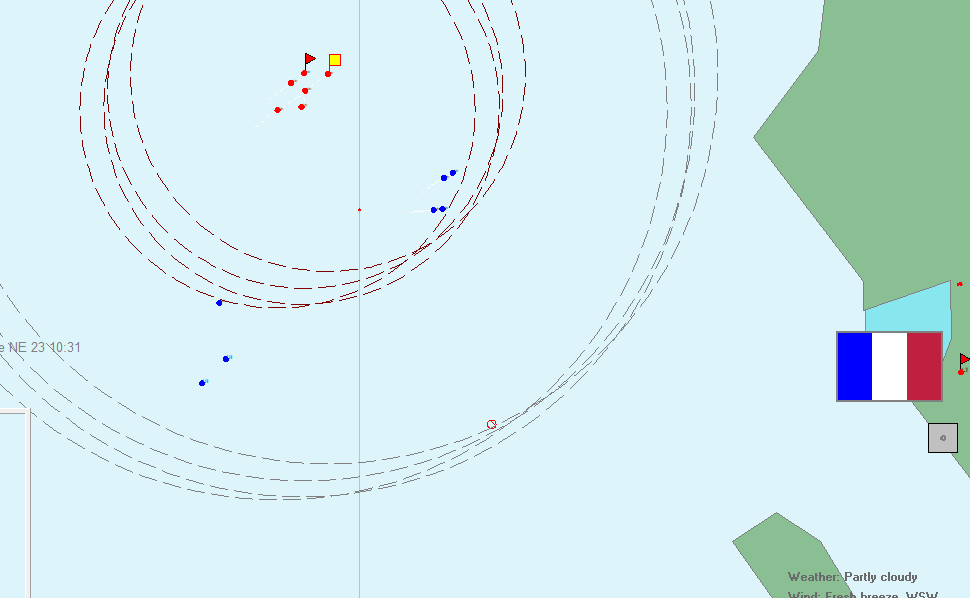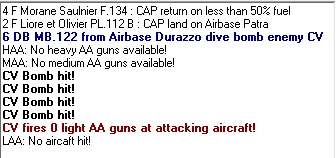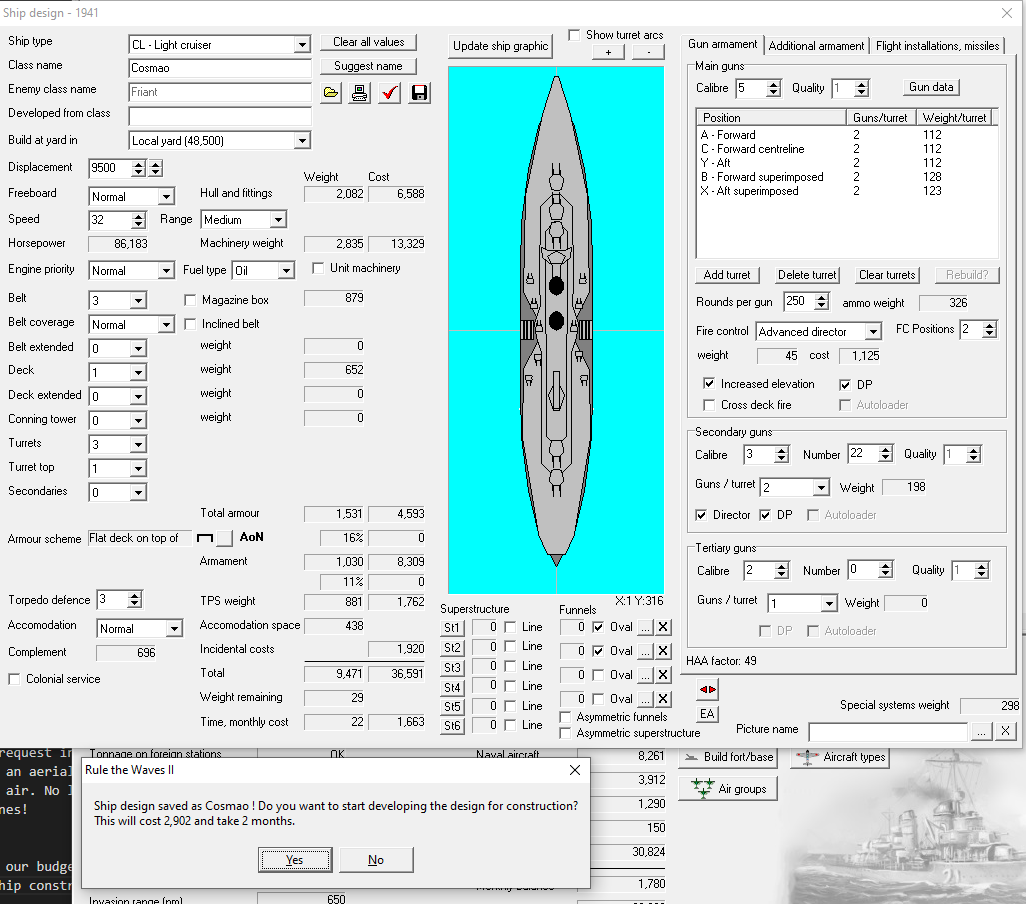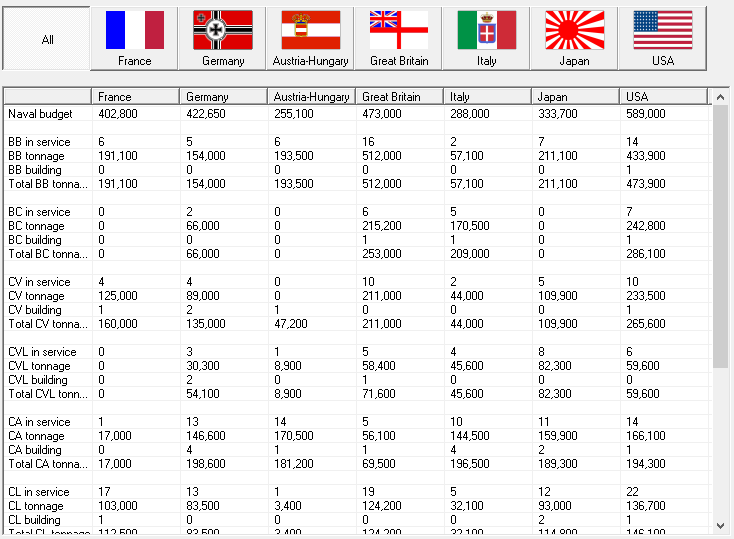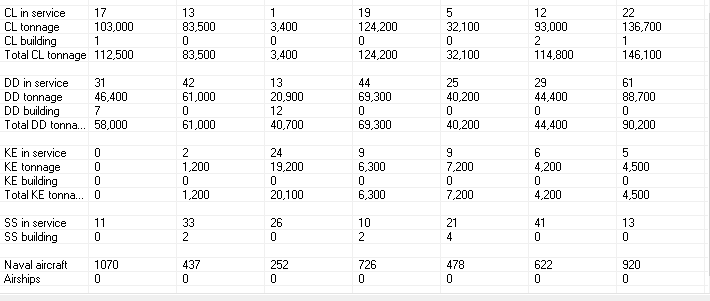Oh dear, I forgot entirely to answer Mike’s post.
Truthfully, I have no idea. I haven’t tried it in the past. The big downside to that is that it’ll decrease the experience of the air groups thus changed in size, and air group experience makes a huge difference to hit rate.
More selfishly, the game bothers you now and then when your air bases have fewer planes than the maximum permitted, and that gets annoying after a few years.
Now, onward to the update.
It has been several weeks, but the end of summer has proven to be busy. Unfortunately, it’s likely to be several more weeks before the next one.
Also, this update turned out to be all text, so we’ll see how closely you’re paying attention. There’ll be a quiz next week.
November 1938
Scrapping the three light carriers, the bevy of obsolete corvettes, and our five oldest submarines, mothballing three battleships and Latouche-Treville, and pausing one of our carriers under construction saves us enough money to move forward. We’re still shedding about 2,700 funds per month, but before we run out of money, we’ll finish building enough things to get back in the black.
Objectives remain as they’ve always been: crush Austria-Hungary, take Morocco, complete our domination of Africa (at least the parts not occupied by the Royal Navy).
It occurs to me that a fun ‘boss fight’ might be v. the UK, provided we can keep the US (or perhaps a resurgent Communist Germany?) on our side.
December 1938
A rebellion breaks out in New Calendonia, halfway around the globe. Evidently a lack of naval force there made it possible. Well, this month, our redeployments should bring our forces around the globe back into accordance with the requirements.
We also unlocked 6" dual-purpose guns (not a sure bet; the chance to get that tech is relatively low), a perfect thing with which to equip our next light cruiser.
Finally, naval intelligence provides us with a brief on how we shot down enemy aircraft in the most recent war. We shot down 27 in total; here’s the breakdown.
-
Fighters: 15
-
Heavy AA: 8
-
Light AA: 3
-
Other aircraft (i.e., defensive armament): 1
So, the clear lesson here is that fighters are the answer, and heavy AA failing that. We didn’t quite face enough air attacks to draw further conclusions, which I suspect accounts for light AA being more effective than medium AA.
January 1939
The government wants to further cut the naval budget, in response to which we put our foot down, throw a tantrum, and manage to head off such wooly-headed talk with only minor concessions.
February 1939
Thanks to the press fearmongering about Italy, we get a nice bump in budget, nearly clearing out our deficit. Since tensions with Italy are already in the high yellow, I’m also going to start moving the fleet into the Mediterranean.
May 1939
French engineers develop an improved surface search radar, which we’ll start mounting to ships as soon as possible.
Only 11 ships in the entirety of the French Navy are not radar-equipped at present—an advantage we may be able to press in a hypothetical war with Italy.
July 1939
Tweaking Austria-Hungary again leads to increased budget. We’re already in the black.
August 1939
Between that increased budget and some global economic expansion, we have enough money for me to bring our three mothballed battleships up to reserve fleet status—wise, considering the rising tensions with Italy and Austria—and to re-activate Latouche-Treville.
September 1939
New Caledonia has thrown off the yoke of its French colonialist oppressors! Which is not great for us, except in that it doesn’t seem to affect our score and also reduces our overseas force requirements enough to bring a Troude home. So actually, it’s pretty great for us.
We also bring a new torpedo bomber into service. It can sling a torpedo as a medium bomb load, which means it has a combat radius of some 380 miles.
October 1939
We go from a slight budget deficit to a surplus of 5,200 funds per month, on the back of a few events and the completion of 12 destroyers. I put the money into a new carrier design (Egalité, except with a deck park and deck-edge lifts for improved aircraft capacity and ease of handling) and another of the Friant-type light cruisers. (I may see about a smaller 6"-gun option to help build out our numbers again.)
November 1939
Several more money-boosting events free up enough moeny for a few more of our corvette-destroyers.
I try a few things to build a better cruiser than the Friant, but the Friant seems to have a pretty good balance of just about everything. Another one goes into the yards.
February 1940
Three submarines and the new Egalité begin construction. I also decide to spend a bit of money rebuilding Bearn, our original carrier. She gains a much heavier AA fit and capacity for six more planes.
April 1940
Morane-Saulnier gets the nod for our next model of dive bomber, with a 1000lb-bomb range of 225 miles and a 250lb-bomb range similar to that of our torpedo bombers.
May 1940
Quite a short break between wars, it looks like. We accuse Austria of torpedoing our old battleship Rouen, driving tensions nearly to the limit.
June 1940
Italy’s rattling sabers, too. Might we get the chance to take on both of our Mediterranean rivals at once?
July 1940
Austria-Hungary declares war.
The first battle is a convoy defense, our destroyers against theirs in the fading moments of dusk. Radar suggests it’s nine of ours against eight of theirs.
It turns out to be exactly so. The French destroyer forces, with the massive advantage of radar—we were able to torpedo the Austrian line from beyond visual range—sink four of the attacking ships in exchange for one loss.
Capabilities, Plans, and Intentions
The Fleets
We are, of course, well-suited to war against Austria-Hungary. They’re a weak power, with a small budget of around 60% of France’s. our six battleships are, on average, newer than theirs, although most of their battleships outgun ours—only the two Austrian 8x13" ships are inferior. Where French ships beat them handily is speed. Suffren is, at 26 knots, the slowest ship we have in service. The fastest Austrian battleship makes 25 knots. We have five battleships in the Mediterranean. Rouen, recently in mothballs, is operating on trade protection duty in the North Atlantic while her crew comes up to speed. (As I’m sure they will. Rouen holds the current record for battle stars in the French fleet, with seven.)
In aircraft, we’re again superior, with more than twice as many as the Austrians, and the ability to bring nearly as many as the Austrians have to their own home waters. One of our carriers, Bearn, is currently under refit, and will be back in service in seven months. Until then, we just have Liberté and Fraternité, representing a combined aircraft strength of 180 planes.
Trade warfare is where we’re inferior, somewhat. The Austrians have thirty submarines to our eight, and six cruisers to our one. We’re also a bit light on light cruisers right now: we have fourteen of them, but most are tied up overseas on foreign service. There are five in home waters, and two of those are our new Friant class, which are still working up in Europe. (I’ll let them get up to speed before sending them into battle.) The other three are obsolescent Voltaire-class ships, built in the late 1920s.
We’ve flipped things around somewhat on destroyers. Our most recent ships are faster, heavier, and better-equipped than their Austrian equivalents.
Things get a little spicier if Italy decides to join in. They’re quite close to us in overall strength, and adding them to Austria would put us on the back foot. Happily, we’re more or less immune to blockades from Austria and Italy—they have no bases in our build zone, so they can’t sustain a large fleet there. Since we have more bases in the Mediterranean than we do even in Northern Europe, we’re perfectly capable of blockading Austria forever. (Not Italy, though. They’re too strong.)
Shipbuilding
Besides the aforementioned Bearn, still in refit, we have seven ships in the yards. We’ll start with three new Arc-class destroyers, which are approximately equal to the most recent Austrian ships but inferior to both sides’ top-line options.
Next are two 90-plane Liberté-class carriers, Egalité (to round out the revolutionary trio) and Terreur (I ran out of positive-sounding French Revolutionary names). At 35,000 tons, they’re the envy of the world, nearly twice as large as most other powers’ largest ships. (Of couse, that does mean it’s a disaster if one of them gets sunk by, say, an Austrian submarine. Knock on wood.)
Finally, we have two more Friant-class light cruisers, 9,400-ton ships with large batteries of dual-purpose guns: 12 5" and 20 3". They also carry mines and torpedoes, but no aircraft. (Nowhere to put them, with all the guns.) Given that our carriers are large, losing the scout planes is no great drawback, especially since most of our battleships carry them now.
War Plans
Pretty straightforward here. Our goals are as before: take Morocco as soon as possible, so that the plot of Casablanca can take place on schedule. An invasion is already being planned.
As far as battles go, we can outmuscle the Austrians in most fights. Battleship actions are a bit iffy, however, given the ship-for-ship Austrian superiority, as are cruiser actions, where we’re badly outnumbered.
On the other hand, I’m absolutely going to take a chance on any battle where there are carriers involved, provided it doesn’t take place in the depths of the Adriatic. Anywhere else in the Mediterranean, we have a massive advantage in our land-based aircraft.
If there’s anything I ought to do differently, now’s the time to mention it.

